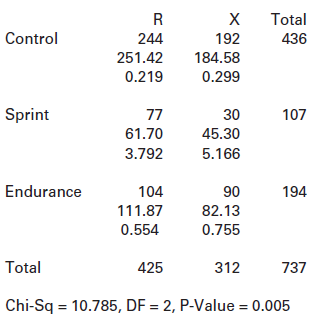The study on genetics and fast-twitch muscles includes a sample of elite sprinters, a sample of elite
Question:

(a) How many endurance athletes were included in the study?
(b) What is the expected count for sprinters with the R allele? For this cell, what is the contribution to the chi-square statistic? Verify both values by computing them yourself.
(c) What are the degrees of freedom for the test? Verify this value by computing it yourself.
(d) What is the chi-square test statistic? What is the p-value? What is the conclusion of the test?
(e) Which cell contributes the most to the chisquare statistic? For this cell, is the observed count greater than or less than the expected count?
(f) Which allele is most over-represented in sprinters? Which allele is most over-represented in endurance athletes?
The gene ACTN3, which encodes a protein that functions in fast-twitch muscles. People can be classified according to which genotype of this gene they have, RR, RX, or XX, and also according to which genetic allele they have, R or X.
Step by Step Answer:

Statistics Unlocking The Power Of Data
ISBN: 9780470601877
1st Edition
Authors: Robin H. Lock, Patti Frazer Lock, Kari Lock Morgan, Eric F. Lock, Dennis F. Lock





